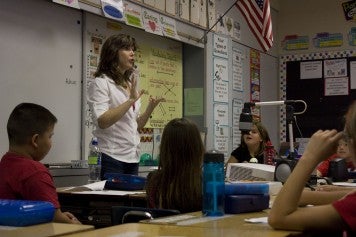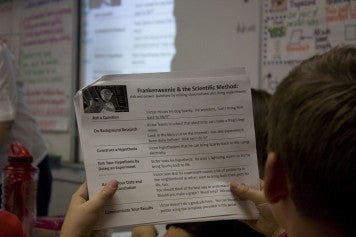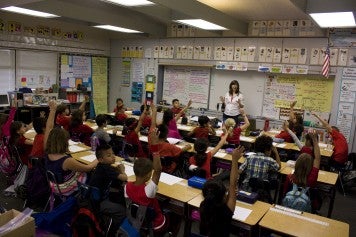RIVERSIDE, Calif. — When Kerry Hanson from the Department of Chemistry at the University of California, Riverside stepped to the front of a third grade classroom at Riverside’s Taft Elementary one day last month, automatically, the students paid attention. They listened, and many shot up their hands when she asked a question.
That day, Hanson and five Chemistry graduate students — Bethany Caulkins, Omar Hamdy, Josh Hartman, Valerie Nichols, and Kelly Theel — led a unique education outreach event for third and fourth graders at Taft.
Their plan: use the popular “Frankenweenie” movie to teach the Taft students the scientific method. In the movie, a young boy, Victor, devises an experiment he predicts will bring his dog–and best friend–back to life.
Victor makes an observation: electricity can reanimate life. He then makes a hypothesis: if he exposes his dog to electricity — here, in the form of lightning, à la Frankenstein — then the animal may be revived. Victor tests his hypothesis, and is proven right.
UC Riverside chemists used the popular “Frankenweenie” movie to teach Taft Elementary students the scientific method.PHOTO CREDIT: LUCAS JOEL.
“I thought the movie, which many kids have seen, would be a perfect backdrop for communicating how the scientific method proceeds,” said Hanson, a professional research chemist. “Also, with Taft pushing for more students to participate in the school’s science fair this year, we’re hoping to show that science — and the scientific process — is doable for everybody.”
Hanson and the graduate students broke off to separate classrooms, and began their presentations by discussing “Frankenweenie.” They then segued into practicing the scientific process.
After learning the scientific method, the kids applied it to a bag of M&M’s. First, they made an observation: this bag has lots of red candy. Next, a hypothesis: there are more red M&M’s in this bag than any other color. And, the test: count the number of each color to see if the hypothesis is correct.
Each class conducted the experiment with several candy bags to see if the results could be reproduced. Results were mixed.
“The main thing we want the kids to realize is that, by performing a science experiment using M&M’s, science — and the scientific method — can be found everywhere in our daily lives,” Hanson said. “We hope that will help dispense of the fear some students may have of science, and, in effect, lead to some great and innovative science fair projects.”
Students at Taft Elementary respond to a question UC Riverside’s Kerry Hanson poses in class.PHOTO CREDIT: LUCAS JOEL.


